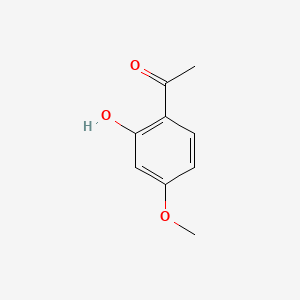Ferroptosis-centered Drug Response Information
General Information of the Drug (ID: ferrodrug0104)
| Name |
Paeonol
|
||||
|---|---|---|---|---|---|
| Synonyms |
PAEONOL; 552-41-0; 2'-Hydroxy-4'-methoxyacetophenone; 1-(2-Hydroxy-4-methoxyphenyl)ethanone; Peonol; 2-Hydroxy-4-methoxyacetophenone; Ethanone, 1-(2-hydroxy-4-methoxyphenyl)-; 1-(2-hydroxy-4-methoxyphenyl)ethan-1-one; 4-O-Methylresacetophenone; Resacetophenone-4-methyl ether; 4'-Methoxy-2'-hydroxyacetophenone; MFCD00008730; Paeonal; Acetophenone, 2'-hydroxy-4'-methoxy-; 2-acetyl-5-methoxyphenol; Resacetophenone, 4-O-methyl ester; EINECS 209-012-2; NSC 401442; UNII-3R834EPI82; BRN 1282794; 1-(2-hydroxy-4-methoxy-phenyl)ethanone; AI3-10581; 3R834EPI82; NSC-401442; RESACETOPHENONE 4-O-METHYL ETHER; CHEMBL1079227; CHEBI:69581; 4-08-00-01793 (Beilstein Handbook Reference); 1-(2-hydroxy-4-methoxy-phenyl)-ethanone; 1-(4-METHOXY-2-HYDROXYPHENYL)ETHANONE; 2-HYDROXY-4-METHOXYPHENYL METHYL KETONE; 2-HYDROXY-4-METHOXYACETOPHENONE (4,4,4-D3); Paeonol (Peonol); PAEONOL [INCI]; 1-[2-hydroxy-4-(methyloxy)phenyl]ethanone; Spectrum2_001981; Spectrum3_001686; PAEONOL [WHO-DD]; 2-Acetyl-5-methoxy-phenol; CBiol_000986; BSPBio_003212; MLS006011902; SPECTRUM1601021; SPBio_002161; SCHEMBL1449478; DTXSID1022059; KBio3_002432; 4-methoxy 2-hydroxy acetophenone; HMS3656E07; HMS3884J13; 2`-Hydroxy-4`-methoxyacetophenone; HY-N0159; BBL012127; BDBM50310718; CCG-39471; ICCB4_000282; NSC401442; s2339; STK078097; AKOS000119646; AC-7982; SDCCGMLS-0066845.P001; 1-(2-hydroxy-4-methoxyphenyl)-ethanone; NCGC00095977-01; NCGC00095977-02; NCGC00095977-03; 2'-Hydroxy-4'-methoxyacetophenone, 99%; AS-15489; SMR000112386; SY013508; 1-(2-Hydroxy-4-methoxyphenyl)ethanone #; 1-(4-Methoxy-2-hydroxy-phenyl)-ethanone; 1-(2-hydroxy-4-methoxyphenyl)ethane-1-one; AM20040702; FT-0602529; FT-0618875; H0789; quinuclidin-3-one oxime hydrochloride;Paeonol; SW219250-1; EN300-17920; A830551; Acetophenone, 2'-hydroxy-4'-methoxy-(7CI,8CI); SR-05000002397; Q-100626; Q7124105; SR-05000002397-1; BRD-K94239562-001-02-2; BRD-K94239562-001-03-0; Z57101020; 2 inverted exclamation mark -Hydroxy-4 inverted exclamation mark -methoxyacetophenone; 2 inverted exclamation marka-Hydroxy-4 inverted exclamation marka-methoxyacetophenone; InChI=1/C9H10O3/c1-6(10)8-4-3-7(12-2)5-9(8)11/h3-5,11H,1-2H
Click to Show/Hide
|
||||
| Structure |
 |
||||
| Formula |
C9H10O3
|
||||
| IUPAC Name |
1-(2-hydroxy-4-methoxyphenyl)ethanone
|
||||
| Canonical SMILES |
CC(=O)C1=C(C=C(C=C1)OC)O
|
||||
| InChI |
InChI=1S/C9H10O3/c1-6(10)8-4-3-7(12-2)5-9(8)11/h3-5,11H,1-2H3
|
||||
| InChIKey |
UILPJVPSNHJFIK-UHFFFAOYSA-N
|
||||
| PubChem CID | |||||
Full List of Ferroptosis Target Related to This Drug
Long-chain-fatty-acid--CoA ligase 4 (ACSL4)
| In total 2 item(s) under this Target | |||||
| Experiment 1 Reporting the Ferroptosis-centered Drug Act on This Target | [1] | ||||
| Target for Ferroptosis | Driver | ||||
| Responsed Disease | Intracerebral hemorrhage | ICD-11: 8B00 | |||
| Responsed Regulator | HOTAIR (IncRNA) | Driver | |||
| Pathway Response | Ferroptosis | hsa04216 | |||
| Cell Process | Cell ferroptosis | ||||
| In Vitro Model | HT22 cells | Normal | Mus musculus | CVCL_0321 | |
| In Vivo Model |
C57BL/6 mice (aged 8-10 weeks, Vital River, Beijing, China) were housed in SPF conditions. The animal study was performed according to the National Institutes of Health Guide and approved by the Ethics Committees of Affiliated Jiangmen Traditional Chinese Medicine Hospital of Jinan University.
Click to Show/Hide
|
||||
| Response regulation | Paeonol (PAN) inhibits the progression of intracerebral haemorrhage via the HOTAIR/UPF1/ACSL4 signalling pathway. Thus, PAN could act as a new agent for the treatment of ferroptosis in intracerebral haemorrhage. | ||||
| Experiment 2 Reporting the Ferroptosis-centered Drug Act on This Target | [1] | ||||
| Target for Ferroptosis | Driver | ||||
| Responsed Disease | Intracerebral hemorrhage | ICD-11: 8B00 | |||
| Responsed Regulator | HOTAIR (IncRNA) | Suppressor | |||
| Pathway Response | Ferroptosis | hsa04216 | |||
| Cell Process | Cell ferroptosis | ||||
| In Vitro Model | HT22 cells | Normal | Mus musculus | CVCL_0321 | |
| In Vivo Model |
C57BL/6 mice (aged 8-10 weeks, Vital River, Beijing, China) were housed in SPF conditions. The animal study was performed according to the National Institutes of Health Guide and approved by the Ethics Committees of Affiliated Jiangmen Traditional Chinese Medicine Hospital of Jinan University.
Click to Show/Hide
|
||||
| Response regulation | Paeonol (PAN) inhibits the progression of intracerebral haemorrhage via the HOTAIR/ UPF1/ACSL4 signalling pathway. Thus, PAN could act as a new agent for the treatment of ferroptosis in intracerebral haemorrhage. | ||||
